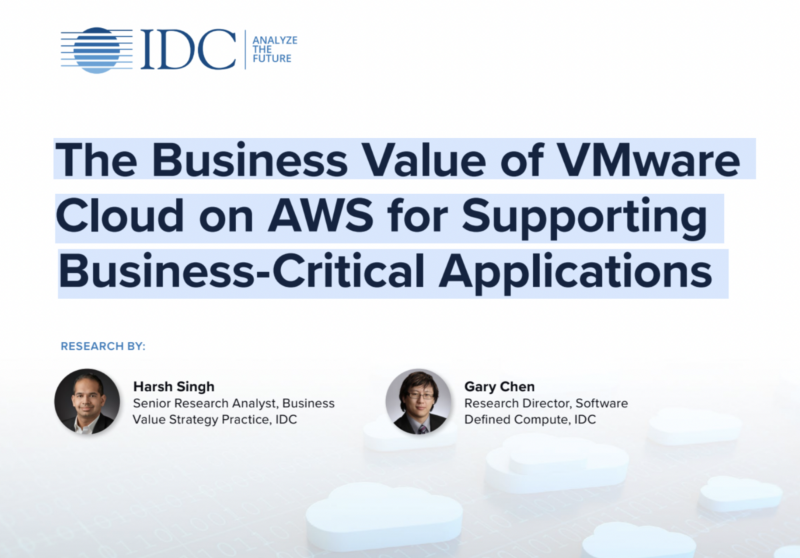The Business Value of VMware Cloud on AWS for Supporting Business-Critical Applications
Published on 16 Nov 2022

Over the last decade, the public cloud has emerged as the dominant force transforming the IT sector. The shift to the cloud is lengthy and complex, including many kinds of workloads and cloud architectures. Existing apps that cannot be feasibly changed or refactored are being migrated to the cloud. While the public cloud represents a significant industry change, on-premises infrastructure will continue to exist. Integrating the public cloud and on-premises systems into a hybrid cloud is essential for preventing the formation of new silos and enhancing flexibility and agility. As a result of the competitive nature of business, businesses will be compelled to innovate, reduce expenses, and generate digital assets more rapidly if they do not adopt cloud computing in all its forms.
VMware's chosen public cloud partner for all vSphere-based workloads is Amazon Web Services (AWS). VMware Cloud on AWS incorporates VMware's Software-Defined Data Center software into the AWS Cloud. It allows users to run production applications across VMware vSphere-based private, public, and hybrid cloud environments with optimum access to AWS resources. This deployment allows enterprises to upgrade their mission-critical applications using jointly developed and maintained AWS and VMware technologies.
IDC questioned businesses from various sectors about the effect of operating their mission-critical apps on VMware Cloud on AWS. Participants in the study recognized significant advantages of utilizing the service, such as easily shifting workloads to the public cloud while maximizing performance, agility, and affordability. In addition, they could use their current VMware technology, expertise, governance, and best practices. Based on interviews with 17 VMware Cloud on AWS clients, IDC estimates that the average yearly benefit per business will be $5.31 million, or $958,700 per 100 virtual machines.
A well-integrated hybrid cloud permits the following:
Smooth transportability
It is possible to transport loads in either direction. Most of its optimizations, integrations and associated administrative processes may be relocated when an application is relocated in a consistent environment.
Integrated networking
Combining both environments into a single logical network eliminates DNS and IP address change difficulties as workloads migrate across environments.
Consistent procedures
Utilizing a single platform enables users to maintain the same operating procedures and manage the whole hybrid environment with a single set of tools inside a single, unified team.
Modernization
Integrated access to cloud-native services may facilitate the modernization and development of current applications.
Solving these integration difficulties will allow the public cloud to become a seamless extension of company data centers, supporting both old and cloud-native applications. Bidirectional mobility also enables enterprises to be adaptable in their mix of on-premises and cloud resources, with the option to modify the proportion as required.
The transition to cloud computing necessitates the use of several cloud technologies. The completely consistent hybrid cloud is an indispensable tool for transferring and administering current data center workloads in the cloud.
Challenges/Opportunities
Challenges
- VMware Cloud on AWS delivers the whole VMware stack with the most recent technologies, including vSAN and NSX, which on-premises clients may still need to use. New clients may have a learning curve, but they will be rewarded with greater capabilities.
- While cloud solutions may be designed to suit diverse technical, security, and compliance needs, soft aspects like trust, cultural resistance, and perceived loss of control can be challenging to overcome, particularly for conservative businesses with a long DIY tradition.
- Customers will evaluate the destiny of each assignment over time, and varied organizational demands and tactics will determine where each burden lands. Even though VMware Cloud on AWS migrates current workloads to the cloud with little effort, some customers may choose not to migrate these workloads and instead operate exclusively cloud-native apps in the public cloud.
- Some workloads may need platform migration to operate natively on the public cloud. Others may be completely retired in favor of a SaaS model. There are a growing variety of possibilities for workloads as cloud computing advances.
Opportunities
- VMware Cloud on AWS provides a simple route to the cloud for current VMware-dependent datacenter applications. The VMware Cloud and AWS interoperability enable the migration of apps with all of its associated tools and procedures.
- For many complicated legacy applications, this may be the only accessible avenue to the cloud.
- Moving applications to VMware Cloud on AWS affords them the potential to be modernized by giving them access to a vast spectrum of native AWS services, including AI/ML and analytics.
- Having equivalent stacks on both ends enables VMware Cloud on AWS's unique bidirectional portability characteristic.
- Due to VMware's dominance in corporate data centers, the VMware platform enables easy migration of workloads to where they are required.
Download IDC's whitepaper to learn more about IDC Business value of VMware Cloud on AWS PDF only on Whitepapers Online.
